Archive for November, 2018
November 30th, 2018 by dave dorsey
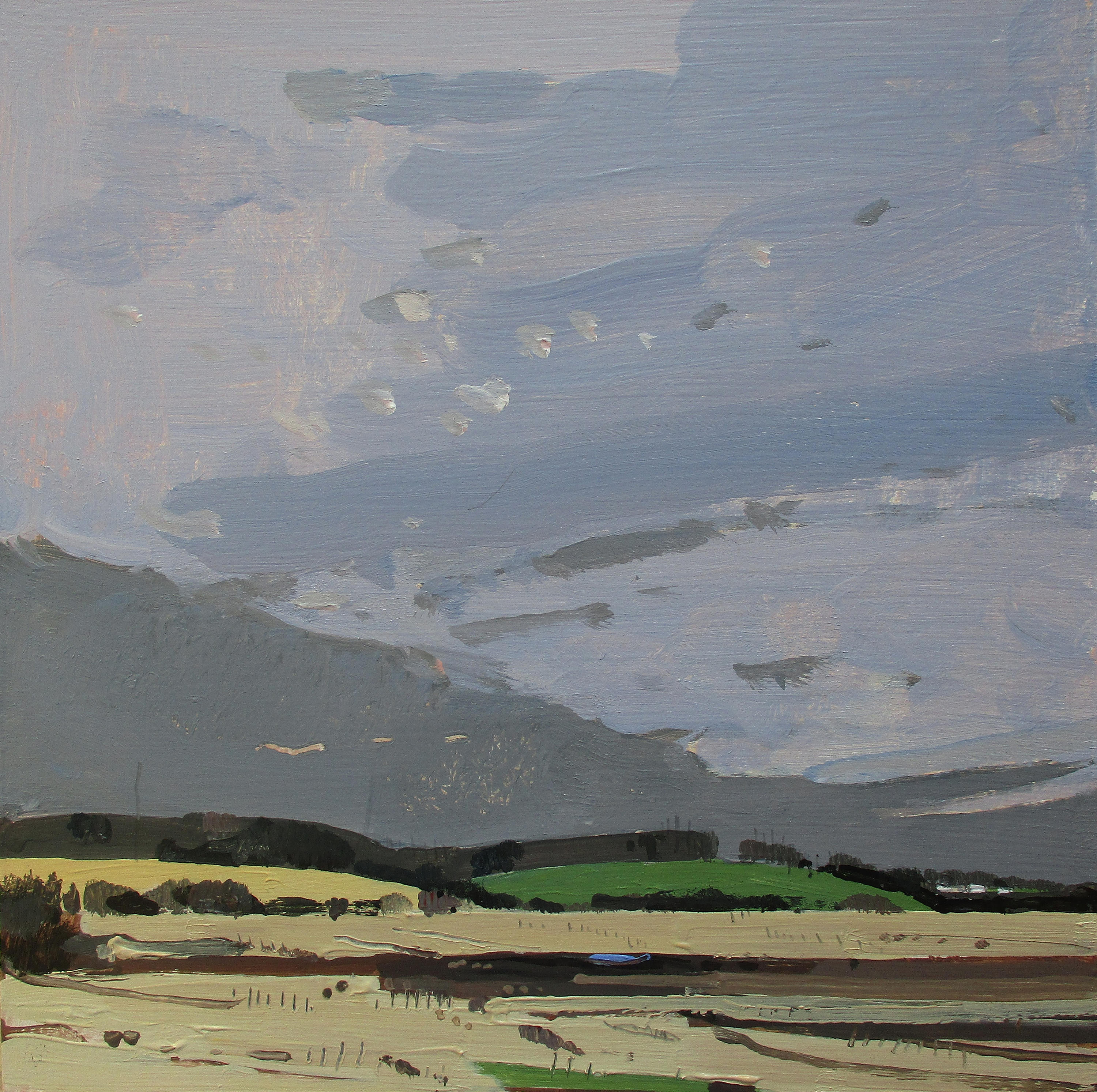
Green Hill, Harry Stooshinoff. 8″ x 8″, acrylic on board
Harry Stooshinoff is a Canadian painter who has conquered the way of a picture-per-day. I hate looking at his Instagram feed because it makes me feel like a total slug, the guy is so incredibly prolific and fast, but also, worst of all, masterful. One glimpse of Harry S. and I just want to give up. Fast is the hardest thing to be as a painter, but he’s flawlessly so. He’s the ultimate premier coup painter, everything done in one sitting. His work looks like en plein air but I think he simply does studies and sketches on site and then improvises from his notes in the studio. You can read a great explanation of the thinking that goes into his process in a well-written little statement here. He posts and sells quite a bit of work online, I gather, for prices that are feudally cheap, but he lives by an economics I find admirable—he can apparently afford to aim high in his work and sell low on the market, which both moves the work and makes it almost universally ownable. It’s a generous strategy that reminds me of Jim Mott’s gift economy. I suspect a lot of teaching in the past is what enables him to do all this now. He can’t be living that far north of Rochester, so I ought to track him down and shake his hand at some point but knowing me, I probably won’t. His methods look utterly transparent, the way Fairfield Porter’s seem to in his best work—no cards pulled out of sleeves, no mystery about how or why that slash of paint happens to be there or do what it does—but try to paint something in such a self-evident way and you will see how Stooshinoff is nearly without equal. Welliver had that quality: you can see what he’s doing all along and would love to do it yourself—“no going back over”—but try it and see what a mess you make.
November 27th, 2018 by dave dorsey
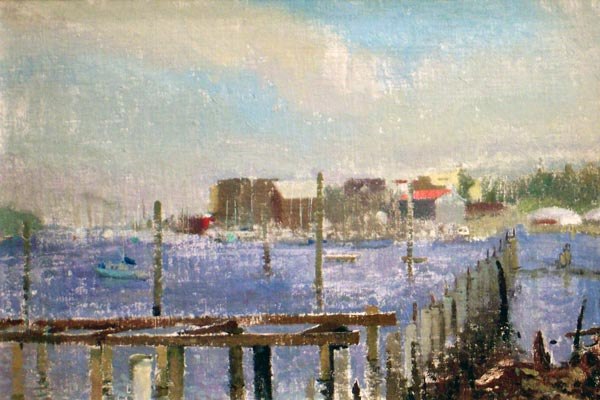
Belfast Bay, Matt Klos, oil on canvas. Absent inches, let’s just say very very small.
This may be, so far, my all-time favorite painting by Matt Klos, which I’ve seen once in a show he had at Oxford Gallery early in this decade, a tiny work, probably done on the spot when he was overseas, I’m not sure. The way he scumbled the paint to allow the canvas to peek through the porous medium gave a perfect shimmer to sea and sky, but it’s the way he used color that really knocked me out. I took a shot of it at the show and have kept it filed away ever since.
November 24th, 2018 by dave dorsey

Another page torn from that 2010 issue of Art News. Every time I think Picasso was the most over-rated painter in the history of Western art, I come across something that makes me think again. This is almost a riposte to Braque’s Canephorae. It was from the Guggenheim’s Chaos and Classicism exhibition. I have to say I prefer this to Braque’s figures–someone once pointed out that Braque invested all of his sensuality in his still lifes, not his nudes–though in almost every other respect, I expect Braque will outlast his rival. But something far more lasting that eroticism shines in this one from Picasso, even though it often seems nearly everything he did had some tangential link to sex.
November 21st, 2018 by dave dorsey
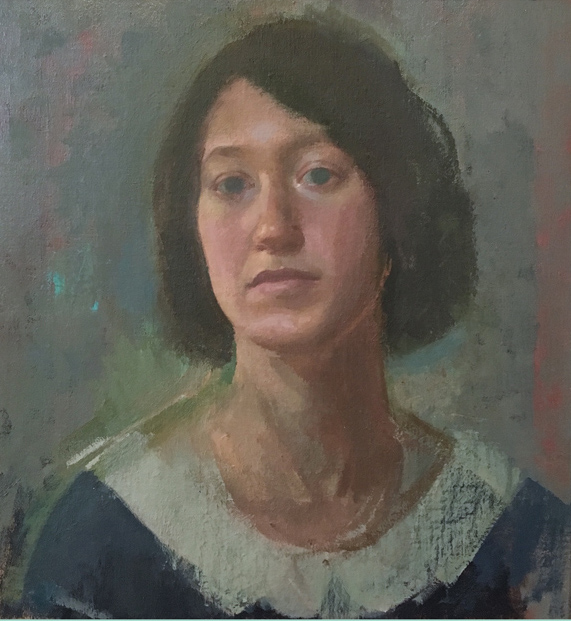
Head, oil on linen, Kathleen Carey Hall
A mother-daughter exhibition at Exeter Gallery promises to be something exceptional for anyone interested in perceptual painting: Eternal Sun, Paintings by Linda Carey and Kathleen Carey Hall. Matt Klos, the director of the gallery, sent out an announcement of the new exhibition last week and included a small sample of what’s on view. One of these paintings is to blame for a string of as-yet unchecked items on my To Do list—I spent much too long for my own good admiring this portrait, entitled simply Head.
The mother-daughter pairing feels like an interesting offshoot of the shows Manifest regularly puts together combining work from teachers and students. From the images Matt sent, these two painters have clearly mastered perceptual painting and used its tropes and techniques to create an individual vision. Both have spent time studying and painting in Italy. Time abroad in that particular nation seems to be one of the best things a painter can choose to do these days—judging by the quality of the work it nurtures, glimpses of which are readily available in the feeds of many painters on Instagram.
On the strength of the images Klos sent along, this is a show not to be missed. One of the two images, this particular portrait of a young woman—self-portrait maybe?—is a marvel of what the perceptual painters advocate. There’s a hint of pentimento, various self-evident ways of making paint itself as much of the point as the image it renders. There’s a deep tension between precision and looseness—or between predictable effects and seemingly risk-taking paint handling, daring the unexpected happy accident to emerge—and it gives a tremendous energy to what is an image of almost absolute stillness. The sitter’s expression is wonderfully ambiguous, serious and a bit lost in thought, but with a smile that seems to be just dawning, though if you try to pin down where this is happening, it’s tough to locate the particular signs of it in her face. It isn’t quite the Mona Lisa smile—somehow it’s even more ghostly and elusive. The background is a layering of so many tones—greenish blue, taupe, a spot of cerulean, pink and almost a stripe of pale rose at the far right, echoing all the colors in the face and lace-collared dress. That collar is wonderful, the way she has dragged the paint lightly over the darker blue of the dress underneath, so that the porous oil hints just enough at the filigree of the fabric to create a totally convincing impression of lace, and somehow—how?— it even looks a little starchy.
The handling of tones is marvelous. Over almost the entire surface, she works in the mid-range of values, keeping the tones muted and the saturation of the paint in the mid-range. But the color of the face itself is slightly more saturated in color and precise in form and line, and as a result it projects out toward the viewer, almost as if the sitter is peering through one of those cardboard images with a hole cut out for the head—but this works in a perfectly natural and evocative way here. As the skin tones come forward, vibrant and alive, the hair and the eyes are filmed in such a way, the tone is so much in the upper registers, that the pupils are entirely obscured and the color of her eyes is entirely indeterminate. Blue? Brown? Are we seeing a faded periwinkle glow reflected off the eye’s surface rather than the color of the iris itself? The effect of all this isn’t just technically impressive, but poetic. It creates that look of being absorbed, absent, remembering, but it also detaches the entire image from the present, so that one is justified in feeling as if this could even be the sitter’s grandmother as a young woman. In a similar way, the hair is almost entirely without detail and in a very light tone, so that in the entire painting there are only two spots of paint that might be considered relatively dark. This, as much as anything, is what I think Klos means in his lyrical appreciation of the two painters, when he writes that the sun of the Renaissance illuminates the work of these two. Piero’s work had this same kind of beatific luminosity.
The only point in the painting where the paint’s value reaches an extreme is in the tiny highlight, not swimming on the surface of the sitter’s eyes, but in the inside corner of one eye—such an original touch, perfectly natural and completely realistic, but almost a modest, easily-overlooked stylistic tour de force, to apply that pinhead of pure light right there, at the corner of the eye rather than somewhere on the cornea, where one would always expect to find it. I’d love to think it was the last mark she made. Once you notice it, the entire painting seems to pivot around that little glint of pure white, serene and blank, where all the other colors in the painting are hidden.
November 18th, 2018 by dave dorsey
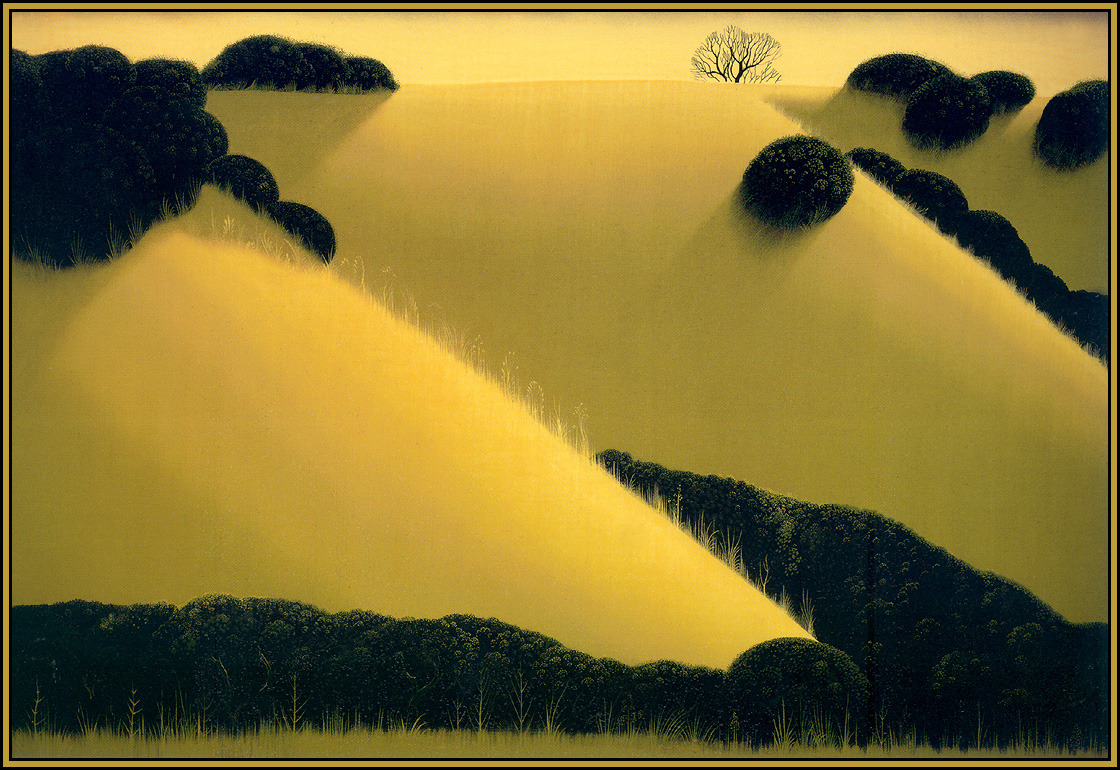
Eyvind Earle (United States, 1916-2000) Golden Hills
“Beauty will save the world.” –Dostoevsky
This and a slew of images to come are from a Tumblr I stumbled onto in the past year, and it has turned out to be a pretty consistent delight for a number of reasons. Its most notable quality is that its contributor often finds and posts work by artists I don’t know or else from a familiar artist I haven’t seen before. I like almost all of what appears here, with an occasional exception, but it’s never predictable and always interesting. The fact that whatever you see at lilacsinthedooryard.tumblr.com surprises me is probably indicative of the limited scope of my knowledge, the massive and perpetual surplus of great painting all over the world from the past couple centuries, and/or the remarkable angling ability of this fisher of artwork, whoever he or she is. There’s a mind behind this site, called Lilacs and Wild Geese, on constant lookout for what French phenomenologist Gaston Bachelard called the oneiric quality, the aura of the waking dream, which really for me is the universal element of great painting that isn’t agitprop or snark or dutiful transcription of what’s seen. But even that last sort of diligence can’t help but become a dream thanks to its idiosyncratic shortfalls. From a Tumblr bearing an epigram from Dostoevsky and a URL from Walt Whitman would one expect anything less?
November 15th, 2018 by dave dorsey
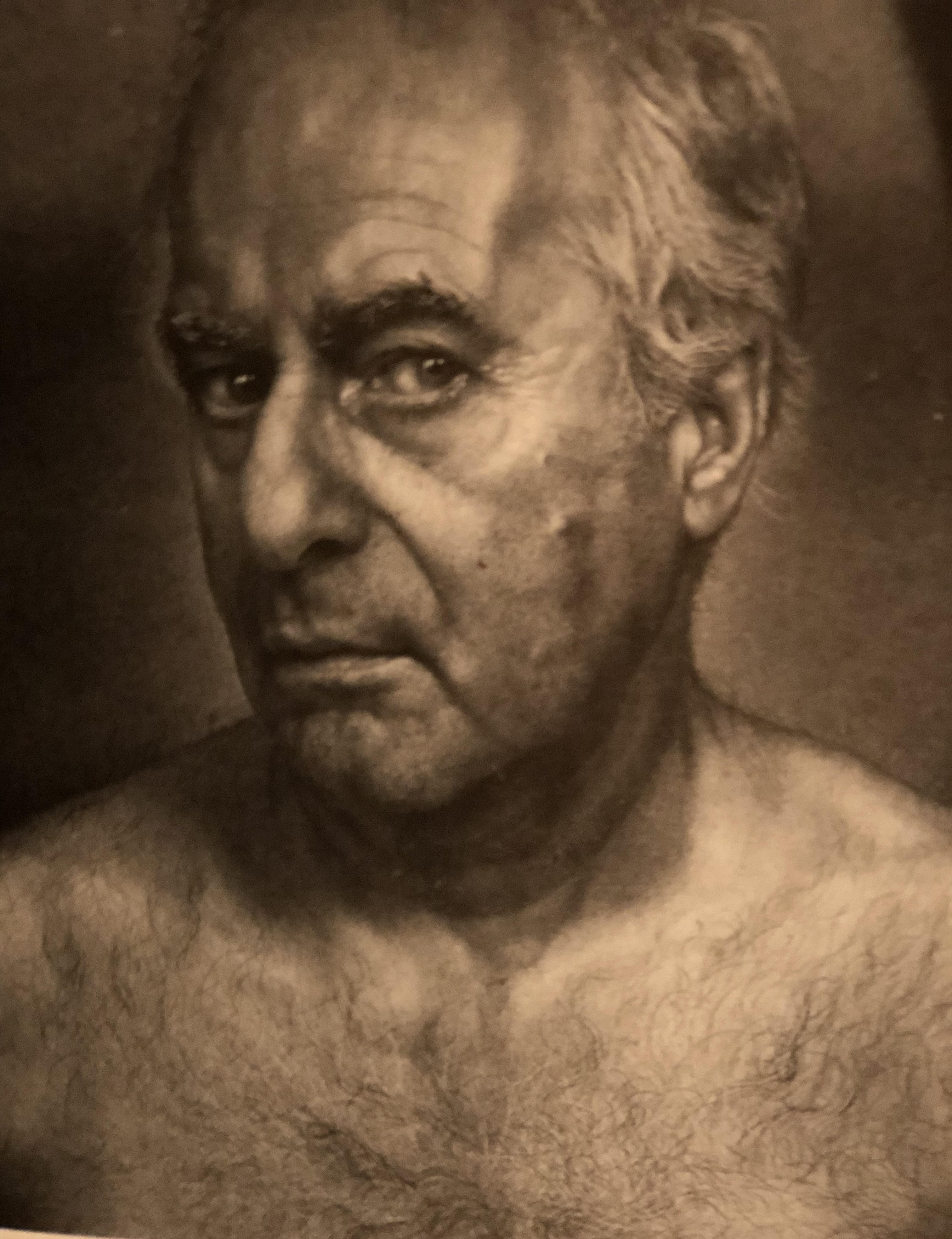
James Valerio, Self-Portrait, 1998, pencil on paper, 21” x 23”
In his studio, Tom Insalaco has a little poster pinned up near a reproduction of an astonishing Franz Halls painting. This drawing was used to promote the show that included it twenty years ago at George Adams Gallery, when it was at 41 W. 57th St.
November 12th, 2018 by dave dorsey
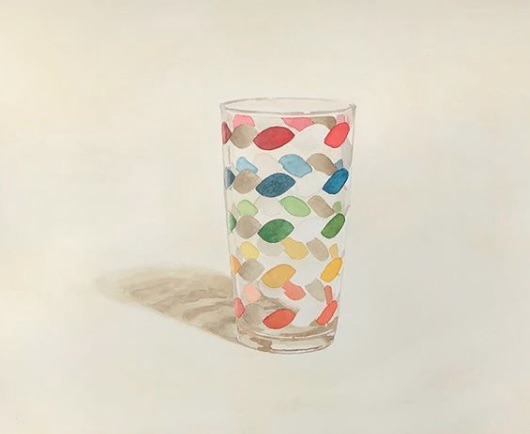
Optimistic Tumbler, Joshua Huyser, Watercolor, 2018
Mrs. Glass had undressed the package and now stood reading the fine print on the back of a carton of toothpaste. “Just kindly button that lip of yours,” she said, rather absently. She went over to the medicine cabinet. It was stationed above the washbowl, against the wall. She opened its mirror-faced door and surveyed the congested shelves with the eye–or, rather, the masterly squint–of a dedicated medicine-cabinet gardener. Before her, in overly luxuriant rows, was a host, so to speak, of golden pharmaceuticals, plus a few technically less indigenous whatnots. The shelves bore iodine, Mercurochrome, vitamin capsules, dental floss, aspirin, Anacin, Bufferin, Argyrol, Musterole, Ex-Lax, Milk of Magnesia, Sal Hepatica, Aspergum, two Gillette razors, one Schick Injector razor, two tubes of shaving cream, a bent and somewhat torn snapshot of a fat black-and-white cat asleep on a porch railing, three combs, two hairbrushes, a bottle of Wildroot hair ointment, a bottle of Fitch Dandruff Remover, a small, unlabelled box of glycerine suppositories, Vicks Nose Drops, Vicks VapoRub, six bars of castile soap, the stubs of three tickets to a 1946 musical comedy (“Call Me Mister”), a tube of depilatory cream, a box of Kleenex, two seashells, an assortment of used-looking emery boards, two jars of cleansing cream, three pairs of scissors, a nail file, an unclouded blue marble (known to marble shooters, at least in the twenties, as a “purey”), a cream for contracting enlarged pores, a pair of tweezers, the strapless chassis of a girl’s or woman’s gold wrist-watch, a box of bicarbonate of soda, a girl’s boarding-school class ring with a chipped onyx stone, a bottle of Stopette–and, inconceivably or no, quite a good deal more. Mrs. Glass briskly reached up and took down an object from the bottom shelf and dropped it, with a muffled, tinny bang, into the wastebasket. “I’m putting some of that new toothpaste they’re all raving about in here for you,” she announced, without turning around, and made good her word.
–Zooey, J.D. Salinger
It’s a bit like an Antonio Lopez Garcia scene, the passage from Salinger where Zooey is smoking in the tub behind a shower curtain and his mother is replenishing the bathroom’s stock of toothpaste. What’s always baffled me, with delight, about J.D. Salinger’s prose is how he can take a deadpan catalog of items in a 1950s medicine chest and bring it quietly to life, until it seems you are watching the cast of a Pixar movie where absolutely nothing happens. Nothing moves. Nothing breathes in there behind the mirror. In this case, nothing moves even when the lights go off. But every one of those little objects has somehow absorbed the life of the people who brought home those notions and creams and razors, concealing them behind the glass in which they see themselves every morning. In a less distinct way, the reader sees those characters too—Zooey and Franny and Bessie—even in this passage, glimpsing them in these simple things that share their life. It’s more than verisimilitude at work here. Somehow, in the way he offers this roster of humble, innocuous Glass family artifacts, though they would have been hardly different from the content of anyone’s medicine chest at the time, Salinger makes them luminous with a quality that’s impossible to name—they are little idiosyncratic treasures of fascinating intricacy, almost human in their individuality, though all of them were mass-produced. You feel as if you’re seeing them for the first time; as if you’ve never quite looked at a nail file before, even though he says nothing more than “a nail file.” They are nothing but what they are; stand for nothing beyond themselves. Yet they seem blessed by the author’s attention, somehow, marvelous because of their ordinariness. You see them the way you would if you’d been brought home after a last-minute pardon on the gallows and were thankful for every least thing in the world. But then everything in Salinger is like that.
That’s how a still life ought to work. It introduces you to the most mundane tokens of life in a way that doesn’t make them into anything they’re not. His prose somehow reveals how incredibly fine it is that they are so perfectly whatever it is they are. I think medicine chests are fast disappearing from this world, but I never open any of the remaining ones without seeing what’s inside with a heightened awareness of the world it embodies and how, in its own way, it shares my time on the earth. Sometimes, thanks to Salinger, what were formerly throwaway moments—applying a Band-Aid, say, or putting to use one of those other assorted less indigenous whatnots—become as worthy of attention and gratitude as anything else I might be doing.
This is all pretty darn close to the way Joshua Huyser’s watercolor portraits of everyday things work. Each time he posts a new painting on Instagram it’s a treat. He doesn’t mess with his subject. He reduces his picture to little more than the thing itself and nothing much else except maybe a shadow. His methods begin to seem like a sort of apophatic discipline, saying no to nearly everything but that quiet little yes in answer to the humble can or bowl or glass he meets gently with careful affection. He’s especially good with glass as if somehow the fact that it verges on total transparency, that it almost isn’t there—like his medium itself and the minimal means he employs—makes one of his paintings a lesson in the actual reality of things and people, all of us here, but oh so tenuously, and so easy to miss. Look at enough of his unspectacular still lifes, and you feel as if his subjects are only ostensibly inanimate objects. They are actually more like living companions on the daily journey, fellow travelers from 6 a.m. to curfew, friends to keep one company in the lonely sort of loving awareness that makes possible painting and a few other things maybe even more worthwhile involving actual, breathing people.
November 9th, 2018 by dave dorsey
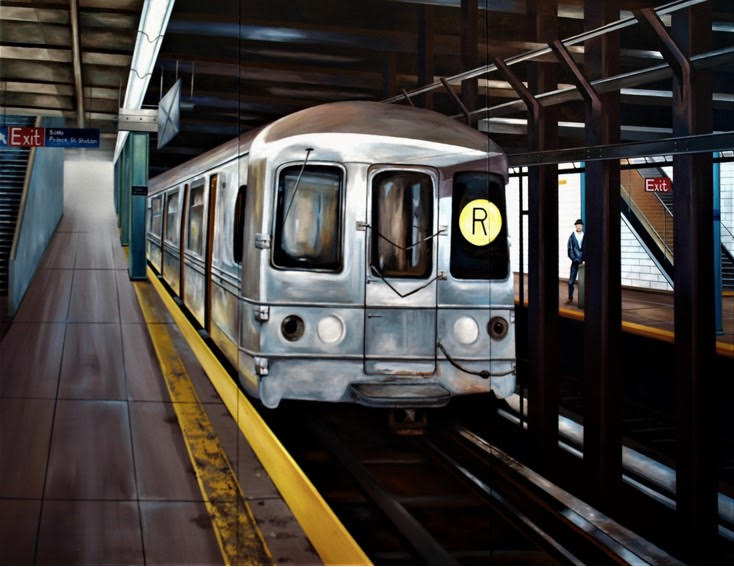
“Let’s Go” 61” x 84” Triptych, acrylic
Street Wise, a solo exhibition of paintings and mixed media by Robert Mielenhausen. He’s moving in different directions from when I knew him as a fellow member at Viridian Artists and it will be interesting to see what he’s up to. The Alfred Van Loen Gallery, South Huntington Library, Nov. 2-Dec. 5. Opening reception, Saturday, Nov. 10, 2-4 p.m., 145 Pidgeon Hill Road, Huntington Station, NY, 11746.
November 6th, 2018 by dave dorsey
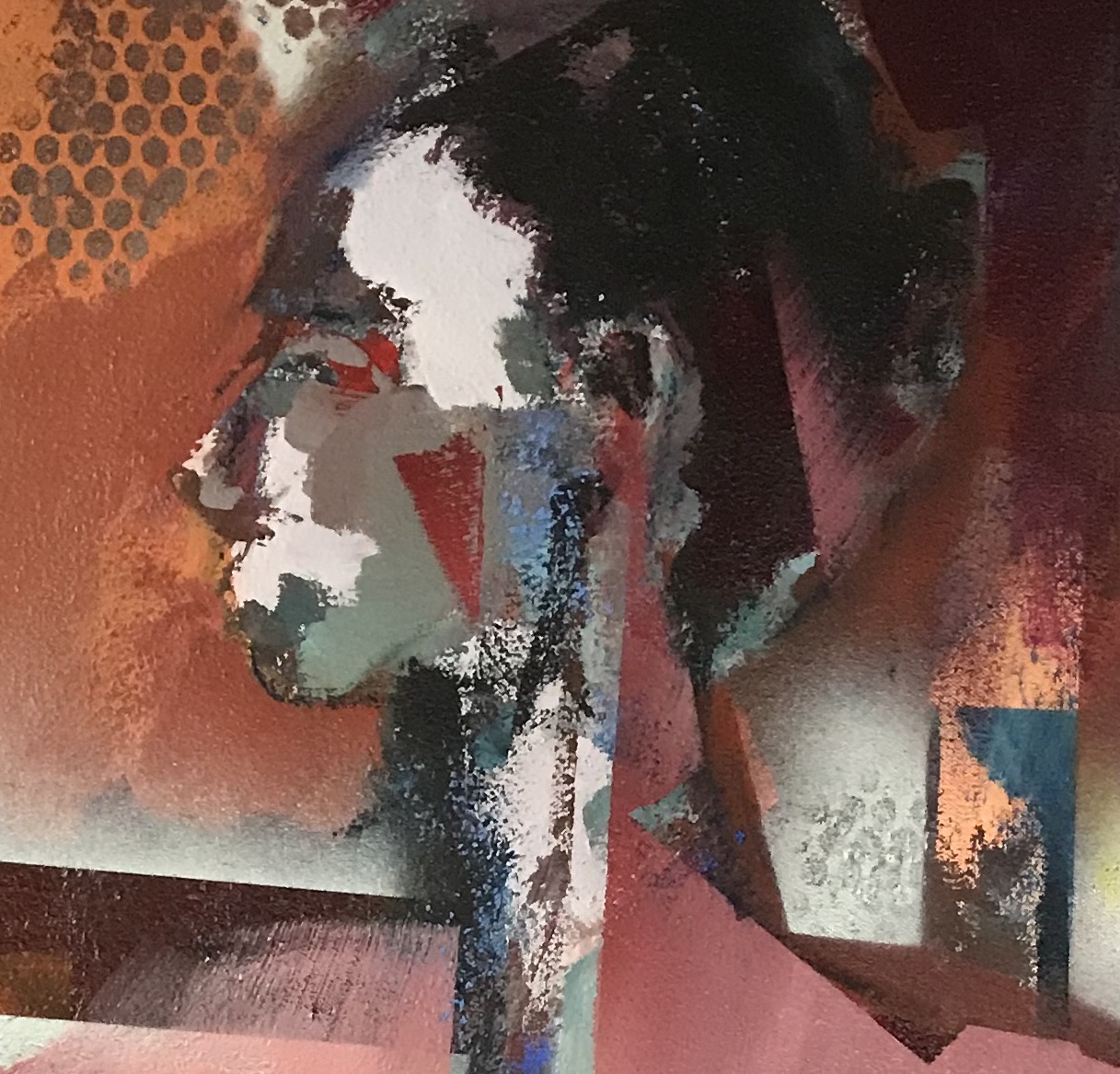
The Eunuch’s Wife, detail, A.J. Dungan, acrylic on canvas
At Oxford Gallery, “Transformation” offers new work from three artists who are finding different ways to split the difference between representation and abstraction.
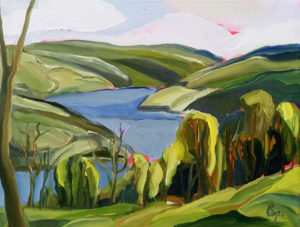
Keuka Bluff, Phyllis Bryce Ely
In my favorite work from Phyllis Bryce Ely, the forms emerge under curls of heavy paint shaped like solidified candle smoke. Lately, and maybe for longer than I’m aware, she’s been laying down an undercoat of bright reddish-orange, as a ground, and then painting in tones complementary to that first coat, letting it peek through here and there the way Thiebaud does, suggesting a field of energy behind the visible. There’s little in the formal qualities of her work that reminds me of Burchfield, except maybe the ghostly way he evoked clouds at night, but her images have a similar numinous quality. Jim Hall’s comparison to the Group of Seven is apt. In her work, there’s more than an echo of Lawren Harris’s glowing landscapes under cold Northern light.
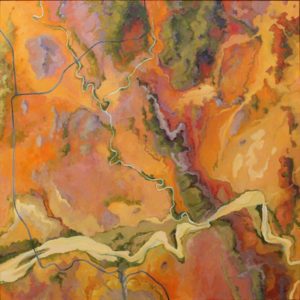
Desert Solitaire 18, Barbara Page
In her aerial views of cultivated land, Barbara Page offers striking abstractions that allow her to improvise with rich, lush color. In Desert Solitaire 18, the course of creeks and rivers rend the image, this way and that, like slow squirming bolts of lightning. Those sinuous lines of pale blue or green or cream break up areas of tilled earth she pushed up the spectrum into red and orange. Like the carefully rendered watershed, the topographical meanderings of edges between woods and field serve as backdrop for boundaries, just as serpentine. And then a blue line, a highway maybe, moves up the canvas, forking into a pair before heading off the edge, suspended over all of it like a line in the sky. As Jim Hall points out on the gallery’s site:
Page came to national prominence with “Rock of Ages, Sands of Time,” an installation consisting of 544 square panels, each panel representing one million years of the history of the earth. The installation formed the centerpiece of the Museum of the Earth, which opened in 2003 outside Ithaca, NY. With uncanny consistency, each panel reads as both a representation of a fossilized remains and as a painterly abstraction, and our fascination resides in its assuming a dual role as object of scientific interest and object of beauty. This project was followed by a similar installation of 268 porcelain tiles lining a pedestrian bridge at the North Carolina Museum of Natural Sciences.
In A.J. Dungan’s recent work, he seems to be pushing toward flatter images—in his last show, some of his figures seemed bulkier, like Bacon’s, where the energy of his brushwork supplemented the sense of depth. Here, many of the paintings look even more Cubist. He uses what appears to be MORE
November 3rd, 2018 by dave dorsey

I think of Mitchell Johnson as the lone wolf of contemporary painting. He’s showing everyone else the way to skirt the system, both academic and commercial, and still make a mark by finding new ways to make modernism his own. I keep watching his feed and envying how much energy he’s able to concentrate into his prolific output. I wish I could have attended this lecture, because the subject really says it all for me: so much of what I love in painting follows from Cezanne and Matisse, even if that awareness is hard to discern in much of what I do. It’s there, though sublimated, yet it’s at the heart of what I respond to most strongly in the work of others.











